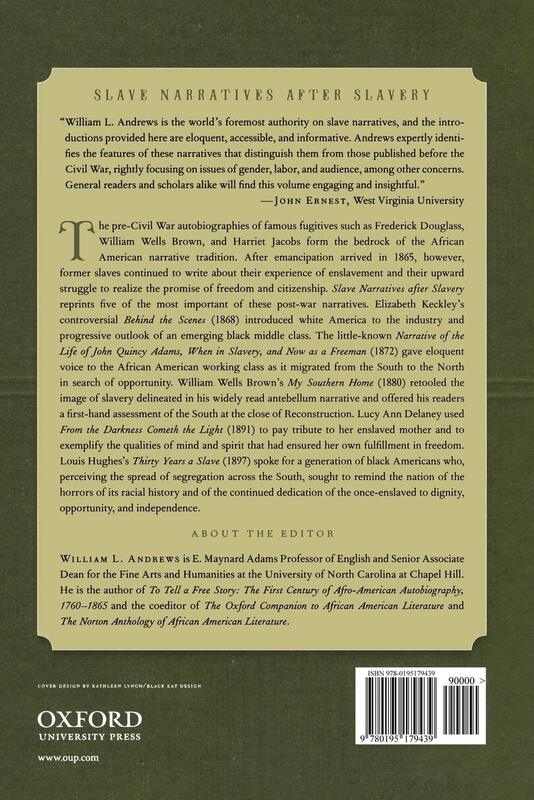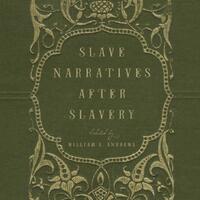Slave Narratives after Slavery
Item
-
Title
-
Slave Narratives after Slavery
-
This edition
-
"Slave Narratives after Slavery". Ed. William L. Andrews. New York: Oxford UP, 2011.
-
Table of contents
-
• William L. Andrews / Introduction (with bibliography)
Note on the text
• Introduction to Keckley and Behind the Scenes
• Elizabeth Keckley / Behind the Scenes, or, Thirty Years a Slave and Four Years in the White House (New York: G.W. Carleton, 1868).
• Introduction to Adams and Narrative of the Life
• John Quincy Adams / Narrative of the Life of John Quincy Adams, When in Slavery, and Now as a Freeman (Harrisburg, Pa.: Sieg, 1872).
• Introduction to Brown and My Southern Home
• William Wells Brown / My Southern Home, or, The South and Its People (Boston: A. G. Brown & Co., Publishers, 1880).
• Introduction to Delaney and From the Darkness Cometh the Light
• Lucy Ann Berry Delaney / From the Darkness Cometh the Light; or, Struggles for Freedom (St. Louis: J. T. Smith, 1891).
• Introduction to Hughes and Thirty Years a Slave
• Louis Hughes / Thirty Years a Slave: From Bondage to Freedom: The Institution of Slavery as Seen on the Plantation and in the Home of the Planter (Milwaukee: South Side Printing Company, 1897).
-
Publisher's description
-
"The pre-Civil War autobiographies of famous fugitives such as Frederick Douglass, William Wells Brown, and Harriet Jacobs form the bedrock of the African American narrative tradition. After emancipation arrived in 1865, former slaves continued to write about their experience of enslavement and their upward struggle to realize the promise of freedom and citizenship. Slave Narratives After Slavery reprints five of the most important and revealing first-person narratives of slavery and freedom published after 1865. Elizabeth Keckley's controversial Behind the Scenes (1868) introduced white America to the industry and progressive outlook of an emerging black middle class. The little-known Narrative of the life of John Quincy Adams, When in Slavery, and Now as a Freeman (1872) gave eloquent voice to the African American working class as it migrated from the South to the North in search of opportunity. William Wells Brown's My Southern Home (1880) retooled the image of slavery delineated in his widely-read antebellum Narrative and offered his reader a first-hand assessment of the South at the close of Reconstruction. Lucy Ann Delaney used From the Darkness Cometh the Light (1891) to pay tribute to her enslaved mother and to exemplify the qualities of mind and spirit that had ensured her own fulfillment in freedom. Louis Hughes's Thirty Years a Slave (1897) spoke for a generation of black Americans who, perceiving the spread of segregation across the South, sought to remind the nation of the horrors of its racial history and of the continued dedication of the once enslaved to dignity, opportunity, and independence" (back cover).
-
Item Number
-
A0596



